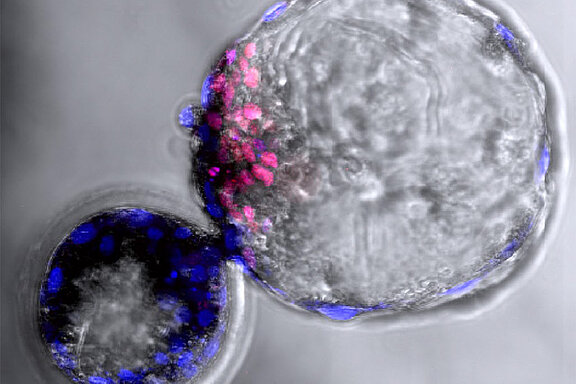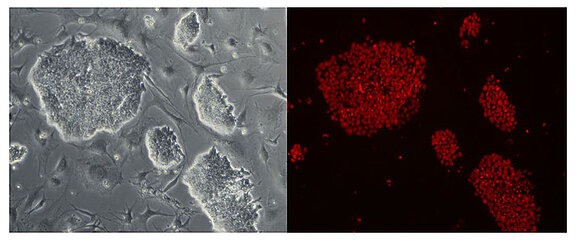Insel Riems, 03. June 2019. In a collaboration between research groups from the Institute of Farm Animal Genetics at the Friedrich-Loeffler-Institut (FLI) in Mariensee, Germany, the Wellcome Trust Sanger Institute in Cambridge, UK and the University of Hong Kong, Li Ka Shing Faculty of Medicine, School of Biomedical Sciences, expanded potential embryonic stem cell lines been obtained from pig embryos for the first time. They offer groundbreaking potential for studying embryonic development and producing translational research in genomics and regenerative medicine, biotechnology and agriculture. The findings were published in Nature Cell Biology.
The “Expanded Potential Stem Cells” (EPSCs) have been efficiently derived from pig preimplantation embryos for the first time. A new culture medium developed in Hong Kong and Cambridge enabled researchers from the FLI to establish permanent embryonic stem cell lines. Dr Monika Nowak-Imialek of the FLI said: “Our porcine EPSCs isolated from pig embryos are the first well-characterized cell lines worldwide. EPSC’s great potential to develop into any type of cell provides important implications for developmental biology, regenerative medicine, organ transplantation, disease modeling and screening for drugs.”
These new stem cells show the typical morphology and gene expression patterns of embryonic stem cells. They can renew themselves and can therefore be kept in culture indefinitely. Compared to somatic cells, which have a limited lifespan, stem cells are much better suited for long selection processes. It has been shown that these porcine stem cell lines can easily be modified with new genome editing techniques such as CRISPR/Cas, which is particularly interesting for the generation of porcine disease models.
One of the unique characteristics of these cell lines is their high capacity to develop not only into numerous cell types of the organism, but also into extraembryonic tissue, the trophoblasts. Therefore, the scientists named them “Expanded Potential Stem Cells” (EPSCs). This capacity could prove valuable for the future promising organoid technology, where organ-like small cell aggregations are grown in 3D aggregates that can be used for research intoearly embryo development, various disease models and testing of new drugs in Petri dishes. In addition, the authors were able to show that trophoblast stem cells can be generated from their porcine stem cells. This type of cell offers a unique possibility to investigate functions or diseases of the placenta in vitro.
In further experiments, the researchers succeeded in differentiating an embryonic porcine stem cell line in primordial germ cell-like cells, PGCLCs, which are precursor cells of oocytes and sperm. An important step in the future would be to investigate to what extent it is possible to produce fertile sperm or oocytes. The new stem cells also provide an important basis for medical stem cell research. Compared to the mouse, the domestic pig is genetically, anatomically and physiologically much more similar to humans and is therefore also a more suitable animal model. Investigation of the mechanism of action and the safety of stem cell therapy in pigs in a large animal model could therefore play an important role for future therapy in humans.
Embryonic stem cells (ESC) are derived from the inner cells of very early embryos, the so-called blastocysts. Embryonic stem cells are all-rounders and can develop into various cell types of the body in the culture dish. This characteristic is called pluripotency. Previous attempts to establish pluripotent embryonic stem cell lines from farm animals such as pigs or cattle have resulted in cell lines that have not really fulfilled all properties of pluripotency and were therefore called “ES-like”.
Publication:
Xuefei Gao, Monika Nowak-Imialek, Xi Chen et al. (2019) Establishment of porcine and human expanded potential stem cells. Nature Cell Biology. DOI: 10.1038/s41556-019-0333-2
Contact:
Monika Nowak-Imialek, Institute of Farm Animal Genetics at Friedrich-Loeffler-Institut
Telephone: +49 5034 871 5119 / Mail: Monika.Nowak-Imialek@~@fli.de
The Wellcome Sanger Institute
The Sanger is one of the world's leading genome and biodata institutes. Through its ability to conduct research at scale, it is able to engage in bold and long-term exploratory projects that are designed to influence and empower science globally. Institute research findings, generated through its own research programmes and through its leading role in international consortia, are being used to develop new diagnostics and treatments for human disease and to understand life on Earth. Find out more at : https://www.sanger.ac.uk/.
About Wellcome
Wellcome exists to improve health by helping great ideas to thrive. 'We support researchers, we take on big health challenges, we campaign for better science, and we help everyone get involved with science and health research. We are a politically and financially independent foundation.'
About LKS Faculty of Medicine, The University of Hong Kong (HKUMed)
The LKS Faculty of Medicine, The University of Hong Kong (HKUMed) is the longest established institution of higher education in Hong Kong. It was founded as the Hong Kong College of Medicine for Chinese by the London Missionary Society in 1887, and was renamed the Hong Kong College of Medicine in 1907.
The Medical Faculty was deemed as the premier Faculty when the University of Hong Kong was established in 1911. Serving Hong Kong for over a century, it has firmly established itself as a medical school of learning, innovation, and enterprising; it is a medical school of moral, vision, and care. Ever since its inception, the Faculty has been playing a pioneering role in medical education, training and research.
From its modest beginnings, the Medical Faculty has now become the largest faculty of the University, with over 400 full-time academic and academic-related staff and over 800 research and research-related support personnel. The undergraduate student population is about 2,900 and the postgraduate student population is about 1,500. The Faculty is comprised of 14 departments, School of Biomedical Sciences, School of Chinese Medicine, School of Nursing, School of Public Health, as well as a number of research centres focusing on various strengths of research. Find out more at: https://www.med.hku.hk/.



